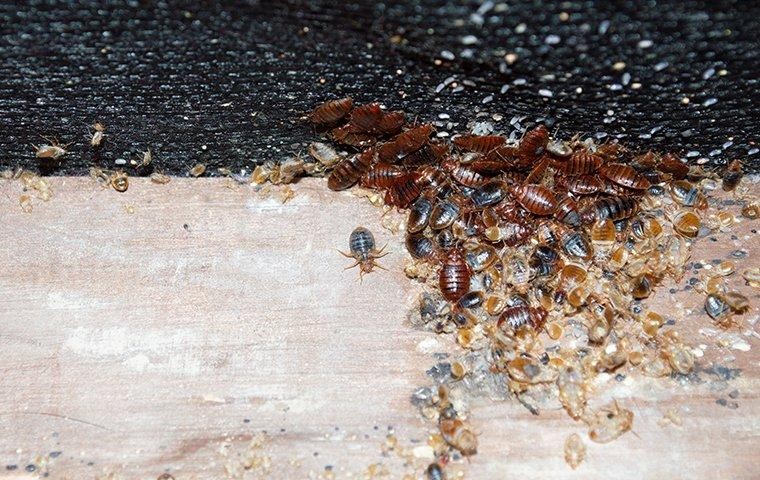No one wants to deal with a bed bug infestation. Unfortunately, these tiny pestilent bugs thrive in your home and can go unnoticed. This article will give you the causes and myths about infestations to stay protected.
Table of Contents
Common myths about the causes of bed bugs
According to the 2018 Bugs without Boarders Survey, bed bug infestations are increasing rapidly across the 50 states in the USA. Myths and misconceptions also spread quickly.. Here are some common myths about the causes of bed bugs that you should not pay attention to;
- Uncleanliness causes bed bug infestations
One of the most prevalent myths is that bed bug infestations only occur in dirty spaces. This assumption is erroneous because these pestilent insects are not drawn decaying organic matter often found in dirty living spaces. So, what attracts them?
Bed bugs are attracted by food and unfortunately, they feed on human blood. You can find them anywhere as long as people are available for them to feed on. A high-end house is in as much risk of a bed bug infestation as an aging building or a budget motel.
- Poverty causes bed bug infestations
For a long time, bed bugs have traditionally been viewed as a problem for developing countries. This misled notion is the main reason some people residing in developed regions fail to pinpoint bed bug infestations. Are you one of those people who believe that bed bugs only attack poor people?
The idea that bed bug infestations can only occur in poverty stricken neighborhoods and households is one of the oldest myths. According to a recent study, bed bug infestations are prevalent in low-income neighborhoods. Does this mean the bed bugs victimize people based on their social status?
Bed bugs do not discriminate based on socio-economic status. The commonness of bug infestations in poverty stricken areas is largely due to social issues arising because of social-economic status. Overcrowding is one of the main issues contributing to bed bug infestations in low-income areas.
- Wooden furniture cause bed bug infestations
Cracks on some wooden furniture provide perfect hiding spots for bed bugs. The notion that wood causes bed bug infestations is wrong, to say the least. Getting rid of wooden furniture in your living space will not lessen the likelihood of a bed bug infestation.
Common causes of bed bug infestations
Exposure to a bed bug-infected environment is the driving force behind the recent rise of bed bug infections in the USA. A huge proportion of the American populace gets exposed to infected environments daily without their knowledge. Here are some common causes of bed bug infestations that you ought to know;
Travel
Travel is the most common cause of bed bug infestations. You often have to share public space with fellow travellers when travelling. When travelling, you have board a bus or any other public transport means and sleep in public spaces such as hotels. According to Bed Bug Statistics 2021, 68% of bed bug infestations in the USA are reported in hotels. What do you think will happen when you are exposed to a bed bug infested space?
Bed bugs are hitchhiking insects. They crawl onto your clothing, suitcases and any other personal belongings and hitch a free ride to your destination. Unbeknownst to you, you will transport the parasitic pests to your home.
Bed bug infestations are pretty challenging to control because people tend to infect different areas as they travel. Apart from hotels, there are several other places where you can contract bed bugs. Here is a list of some public spaces where contamination are common;
- Hotels, resorts, motels, and hostels
- Rental Apartments
- AirBnBs
- Public shelters
- Public transport vehicles such as buses, trains, cruise liners, and taxis
- Office buildings
- Colleges and Universities
- Libraries
- Police stations
- Theatres
- Schools
- Police stations
Thrift stores and charity shops
As I mentioned above, bed bugs are hitchhiking insects because they crawl onto clothes, luggage, and other personal belongings. People often bring them into thrift stores and charity shops on secondhand items such as furniture and clothes. Picking up secondhand items from such establishments increases the risk of a bed bug infestation.
What should you do if you must buy second-hand items or pick up some items from a charity shop? Inspecting second-hand items for signs of a bed bug infestation is advisable. The most predominant signs of a bed bug infestation include;
- Bed bug exoskeletons: Bed bugs tend to leave behind lots of exoskeletons after molting. These exoskeletons are visible through the naked eye.
- Rusty-colored blood spots: Generally, bed bugs excrete rusty-colored blood-like fecal material because they consume a lot of blood. You will easily notice these spots on your mattress and furniture if you reside in a bed bug-infested space.
- Sweet, musty scent: Typically, bed bugs tend to emit a sweet, musty scent.
Visiting a friend’s or family member’s place
You can have bed bugs when visiting friends or family members. Most people find it challenging to admit to having bed bugs. If you spend time in an infested space, they will crawl onto your belongings and hitch a free ride to your place. It is advisable to watch for signs of bed bug infestation when visiting friends or family members.
If you suspect that your belongings are contaminated, you should isolate them. You can put them in a plastic bag to avoid contamination.
You can use a steamer, washing machine, or dryer to kill bedbugs at home. A temperature of 118°F (48°C) will kill adult bedbugs after 20 minutes and need 90 minutes for eggs. You can kill them instantly with temperatures above 160°F (71°C).
Alternatively, if you have delicate fabric that cannot be washed at high temperatures, you can put them in a plastic bag and store it in the freezer for at least 4 days.
A guest visiting your place
Bed bugs often find their way into your home via guests who unintentionally carry them on their possessions. You ought to be wary when you have guests in your home, especially if they spend the night. It is in your best interest to take precautionary steps to minimize the chances of an infestation when hosting guests. Here are a few precautionary steps that you should implement;
- Avoid putting your guests’ belongings on the bed. Clean out one of your closets and use it to store your guests’ belongings. After they leave, you must vacuum the closet and dispose of the vacuum bag immediately.
- Use mattress covers to protect the bed. You must also wash the bedsheets in hot water when the guests leave.
- Request your guests to place their shoes on a mat by the door. Clean the mat thoroughly when they leave.
Your neighbor’s apartment unit is infested.
Bed bugs can crawl into your home from a neighbor’s infested apartment if you live in an apartment complex. These pesky pests can crawl through tiny cracks on walls or interconnecting pipes. So, anything that links you to other apartment units puts you at risk of a bed bug infestation.
Staying alert and watching out for signs of an infestation put you in a better position to protect your space. You can monitor bed bugs infestation with traps.
How do bed bugs spread?
Bed bugs do not have wings. This raises the question, how exactly do they spread from room to room or house to house? They do not fly, they do not jump, they are crawling. They can move within wall cracks, ceilings and plumbing pipes.
If crawling were the only means through which bed bugs move from place to place, they would spread slowly. Bed bugs spread faster because they are hitchhiking on people’s clothing, luggage, and furniture. We often spread the bugs from one place to another unknowingly.
Frequently Asked Questions
How do bed bugs spread from house to house?
Bedbugs travel from house to house by attaching to things.
Can bed bugs spread person to person?
Bedbugs do not jump or fly. They crawl from person to things and from things to person.
How far will a bed bug travel?
Bed bugs like to stay close to their food. They generally stay around 20 feet from their meal. They can travel longer distances and infect other places by hitchhiking on people’s clothes, furniture, and luggage.
Can bed bugs crawl in from outside?
Bed bugs do not go outside by choice. They are brought outside when they attach themselves to clothes, bags, and shoes. They can also enter your home through the same means.
Can bed bugs be isolated to one room?
Bed bugs can easily crawl from room to room through walls and pipes. They can go through any little crack. You cannot isolate bedbugs to only one room.
Can I get bed bugs from someone riding in my car?
Yes. If someone with bedbugs rides in your car, they can crawl off and hide in the car. Once the bed bugs are in the car, they can crawl onto your clothes and belongings and hitch a ride into your home. The same is true for taxis and Uber cars.
Can you get bed bugs from someone sitting on your couch?
Yes, you can. If someone carrying bedbugs sits on your couch, they will crawl onto your couch and hide.
How fast do bed bugs crawl?
They can crawl a distance of up to 4 feet per minute. That’s really fast compared to their size.
Can hugging someone give you bed bugs?
It’s not impossible, but the risk of contracting bedbugs through a hug is low. You cannot generally get bedbugs from a person-to-person contact.
Final thoughts
We all spend a considerable amount of time away from our homes. From the time you step out of your home, you are at risk of picking up bed bugs. Here are some steps that you can take to avoid bed bugs infestations;
- Inspect your space for any signs of bed bugs regularly.
- Watch out for signs of bed bug infestations in public spaces and second-hand products you buy.

